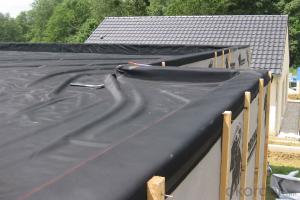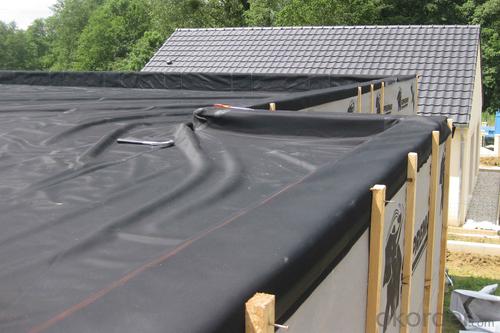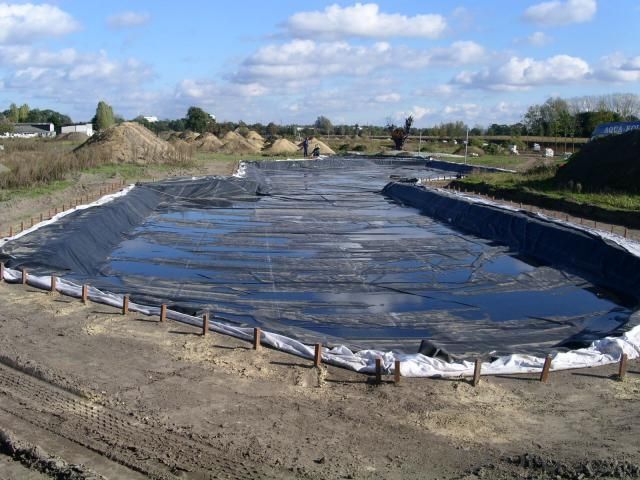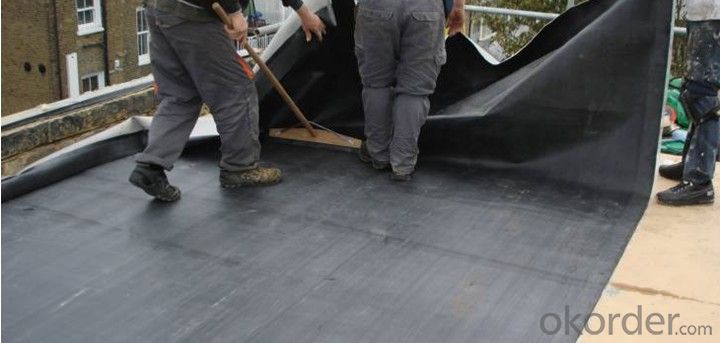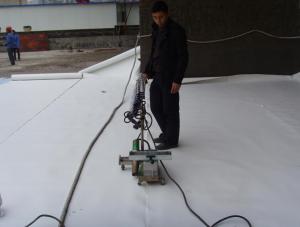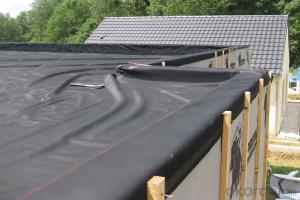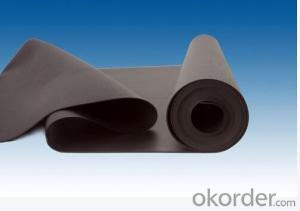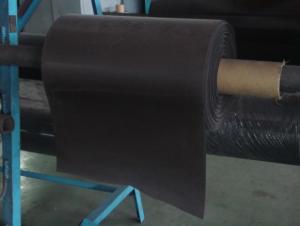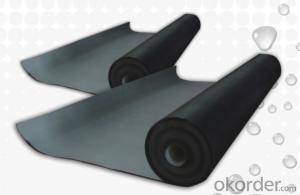EPDM Waterproofing Membrane for Wooden House
- Loading Port:
- Shanghai
- Payment Terms:
- TT OR LC
- Min Order Qty:
- 50000 m²
- Supply Capability:
- 5000000 m²/month
OKorder Service Pledge
OKorder Financial Service
You Might Also Like
EPDM Waterproofing Membrane for Wooden House
Description Of EPDM Waterproofing Membrane for Wooden House:
This waterproof coiled material is of high elasticity with best performance among high polymer waterproof coiled material in the world.It is also the most typical one in the world.Waterproof coiled material made of ternary ethylenepropylene rubber of KINTOPbrand is produced with the use of the most advanced continuous extrusion and vulcanization technology and related equipments which are specially designed for production of such product.It is good in compactness,without bubble and performance difference in length and breadth.
Main Features of EPDM Waterproofing Membrane for Wooden House:
1>Excellent anti-aging performance, service life up to 50 years
2>Working well with in -40°C to 100°C,it can be constructed with a single layer in ambient temperature.
3>Waterproofing on various kinds of underground project,industrial of civil buildings and structures.
4>high extension rate, high tensile strength, small size changes at heat treatment
5>Good plant roots penetrability resistance and can be made waterproofing layer of planting roof
6>Special modified molecular structure ,effectively resolving the current domestic and foreign glue
joint problem .
7>Good low temperature flexibility, and good performance of adapting to ambient temperature
changes.
8>Convenient application ,solid joint, no environment pollution
9>chemical corrosion Resistance, can be used for special occasions
Specifications of EPDM Waterproofing Membrane for Wooden House:
Type | EPDM Rubber Waterproof Membrane | ||
Type | Vulcanized and Weldable | ||
Thickness | 1.2mm | 1.5mm | 2.0mm |
Weight(kg/m2) | 1.54-1.58 | 1.79-1.83 | 2.25-2.29 |
Size | 1.2m (width) * 20m (length)/roll. Weldable type could be 4m wide. | ||
Packing | 24㎡/roll, with plastic bag. (Weldable: 80㎡/roll) | ||
Usage | Roof, basement, pond, Lake, steel structure roofing, underground, tunnel, etc | ||
NO. | Item | Unit | Technical requirement | |
1 | Tolerance on size | Thickness | % | ±10 |
Width | % | ±1 | ||
length | % | Does not allow negative | ||
2 | Fracture tensile strength (normal temperature ) | Mpa | ≥7.5 | |
Fracture tensile strength(60 ℃) | Mpa | ≥2.3 | ||
3 | Breaking elongation,(normal temperature ) | % | ≥450 | |
Breaking elongation,(-20 ℃) | % | ≥200 | ||
4 | Tearing resistance | KN/m | ≥25 | |
5 | Impermeability | * | 0.3Mpa impermeable | |
6 | Bending at low temperature | °C | ≤-40 | |
7 | Elongation and contraction volume at heating | Elongation | mm | ≤2 |
contraction | mm | ≤4 | ||
8 | Hot air aging 80°CX168h | Fracture strength retention | % | ≥80 |
Rate of elongation at break | % | ≥70 | ||
9 | Alkaline (saturated Ca(OH)2 solution normal Temperature x2 168h ) | Fracture strength retention | % | ≥80 |
Rate of elongation at break | % | ≥80 | ||
10 | Ozone aging (40 degree by 168 hours ) | Elongation 40% , 500x10-2 | * | No Crack |
11 | Phytotron aging | Fracture strength retention | % | ≥80 |
Rate of elongation at break | % | ≥70 | ||
Applications of EPDM Waterproofing Membrane for Wooden House:
Widely used in roofs, basement, toilet ,swimming pool, and all kinds of industry and civil building waterproofing, reservoir, vivicism, bridge, underground, tunnel and dam waterproofing ,especially to the keystone waterproofing projects which is durability, high corrosion resistance and easy deformation.
Construction Site of EPDM Waterproofing Membrane for Wooden House:



IMages of EPDM Waterproofing Membrane for Wooden House:




FAQ of EPDM Waterproofing Membrane for Wooden House:
1. What are we supplying?
We are specialized in producing Colorful Asphalt Roof Shingle, SBS/APP modified bitumen waterproof membrane, Self adhesive bitumen waterproof membrane, PVC waterproofing membrane, EPDM rubber roofing membrane, Single Component Polyurethane Waterproof Coating, and Spray Polyurea Waterproof Coating
.
2. How Many years experience do we have?
We have been exported to more than 20 countries in the past 15 years.
3. How long do we usually reply your request?
We always reply our customer within 24 hours.
- Q: APP selection of asphalt waterproofing membrane selection points
- 5, membrane and coating composite use should be compatible, and should be placed on top of the coating; coil and waterproof mortar composite use should be placed under the waterproof mortar.
- Q: Are there any specific requirements for installing a waterproofing membrane?
- Yes, there are specific requirements for installing a waterproofing membrane. These requirements may vary depending on the type of membrane being used and the specific application. However, some general requirements include: 1. Surface Preparation: The surface where the membrane will be installed must be clean, dry, and free from any dust, debris, or contaminants. Any cracks or defects in the surface should be repaired prior to installation. 2. Adhesive or Bonding Agent: Depending on the type of membrane, an adhesive or bonding agent may be required to ensure proper adhesion to the substrate. This adhesive should be compatible with both the membrane and the substrate. 3. Primer: In some cases, a primer may be necessary to enhance the adhesion between the substrate and the membrane. The type of primer required will depend on the specific membrane and substrate being used. 4. Seam and Joint Preparation: Properly preparing seams and joints is crucial to ensure a watertight installation. This may involve using a specific sealant or tape to reinforce the seams and prevent water penetration. 5. Installation Techniques: The membrane should be installed according to the manufacturer's instructions and industry best practices. This may include using a specific method such as torching, hot air welding, or cold adhesive application. 6. Overlaps and Transitions: Properly overlapping the membrane sheets and ensuring smooth transitions between different areas is essential for a successful installation. This will help prevent water from seeping through gaps or weak points in the membrane. 7. Quality Control: Regular inspections and quality control measures should be implemented throughout the installation process to ensure that the membrane is being installed correctly and meets the required standards. It is important to consult the manufacturer's guidelines and specifications for the specific waterproofing membrane being used, as different membranes may have unique installation requirements. Additionally, local building codes and regulations should also be considered to ensure compliance and to meet any specific requirements in your area.
- Q: Can a waterproofing membrane be used for a swimming pool deck?
- Yes, a waterproofing membrane can be used for a swimming pool deck. Waterproofing membranes are designed to provide a barrier against water infiltration, which makes them suitable for protecting the pool deck from water damage and ensuring its longevity.
- Q: Can a waterproofing membrane be used in renovation or retrofitting projects?
- Yes, a waterproofing membrane can definitely be used in renovation or retrofitting projects. This membrane is designed to create a barrier against water penetration, which is essential in protecting the building structure from moisture damage. By applying a waterproofing membrane during renovation or retrofitting, it helps prevent water infiltration, dampness, mold growth, and potential structural issues.
- Q: SBS modified asphalt waterproofing membrane and synthetic polymer membrane the same, not the same, what is the difference?
- SBS modified asphalt waterproofing membrane is a kind of high-polymer modified asphalt waterproofing membrane, high polymer modified asphalt waterproofing membrane is synthetic polymer modified asphalt coating layer,
- Q: Can a waterproofing membrane be used for military facilities?
- Yes, a waterproofing membrane can be used for military facilities. Waterproofing membranes are commonly used to protect structures from water infiltration and damage, which is crucial in military facilities to ensure the integrity and longevity of the infrastructure. Additionally, waterproofing membranes can also provide additional benefits such as protection against chemical and environmental hazards, making them suitable for military applications.
- Q: How does a waterproofing membrane work?
- A waterproofing membrane is a barrier that is applied to a surface to prevent water from penetrating it and causing damage. The membrane is typically made of a flexible material, such as rubber or plastic, which is resistant to water. The primary function of a waterproofing membrane is to create a continuous layer of protection that prevents water from seeping through the surface it is applied to. This can be particularly important in areas that are prone to moisture, such as basements, roofs, and bathrooms. When a waterproofing membrane is applied to a surface, it forms a seamless and impenetrable barrier that prevents water from passing through. The membrane is typically installed in multiple layers to ensure maximum protection. These layers are often reinforced with materials like fiberglass or polyester to enhance their strength and durability. In addition to preventing water from penetrating a surface, a waterproofing membrane also helps to redirect water away from the area. The membrane is designed in a way that encourages water to flow towards drains or other designated outlets, effectively channeling it away from the protected area. Furthermore, a waterproofing membrane is also resistant to the effects of moisture, such as mold and mildew growth. By blocking the entry of water, it helps to maintain a dry and healthy environment. Overall, a waterproofing membrane is a vital component in protecting structures and surfaces from water damage. It provides a reliable and long-lasting solution for preventing leaks, seepage, and moisture-related issues, ensuring the longevity and integrity of the protected area.
- Q: Can a waterproofing membrane be used on interior walls?
- Interior walls can indeed benefit from the use of a waterproofing membrane. These membranes are specifically designed to create a barrier against moisture, thus preventing any water from seeping into the surface and causing damage. Although their primary use is to protect exterior walls from rain and groundwater, they can also be employed on interior walls that are susceptible to moisture, such as bathrooms, kitchens, or basements. By applying a waterproofing membrane, you can effectively shield the interior walls against water damage, the growth of mold, and other issues related to moisture. However, it is crucial to keep in mind that the choice of the appropriate type of waterproofing membrane and the correct installation technique should be based on the specific requirements and conditions of the interior walls. To ensure proper application and long-lasting protection, it is highly recommended to seek the advice of a professional or follow the guidelines provided by the manufacturer.
- Q: Can a waterproofing membrane be applied in cold weather conditions?
- Applying a waterproofing membrane in cold weather is possible, but the temperature range may differ depending on the product and manufacturer guidelines. Certain membranes can endure cold temperatures and be applied as low as -20 degrees Celsius (-4 degrees Fahrenheit), while others may have a higher minimum application temperature. Following the manufacturer's instructions is crucial, as well as ensuring the surface is adequately prepared and free from ice, snow, or moisture. Consulting with an experienced professional contractor who has worked with waterproofing membranes in cold weather conditions is also recommended for optimal results.
- Q: Can a waterproofing membrane be used on plaster surfaces?
- Yes, a waterproofing membrane can be used on plaster surfaces. Plaster is a porous material that can easily absorb water, making it susceptible to damage from moisture. Applying a waterproofing membrane on plaster surfaces helps to create a barrier that prevents water from penetrating the plaster, thus protecting it from moisture-related issues such as mold, mildew, and deterioration. It is important to ensure that the plaster surface is clean, dry, and free from any loose or flaking material before applying the waterproofing membrane. Additionally, proper surface preparation and application techniques should be followed to ensure the effectiveness and longevity of the waterproofing system.
Send your message to us
EPDM Waterproofing Membrane for Wooden House
- Loading Port:
- Shanghai
- Payment Terms:
- TT OR LC
- Min Order Qty:
- 50000 m²
- Supply Capability:
- 5000000 m²/month
OKorder Service Pledge
OKorder Financial Service
Similar products
Hot products
Hot Searches
Related keywords
